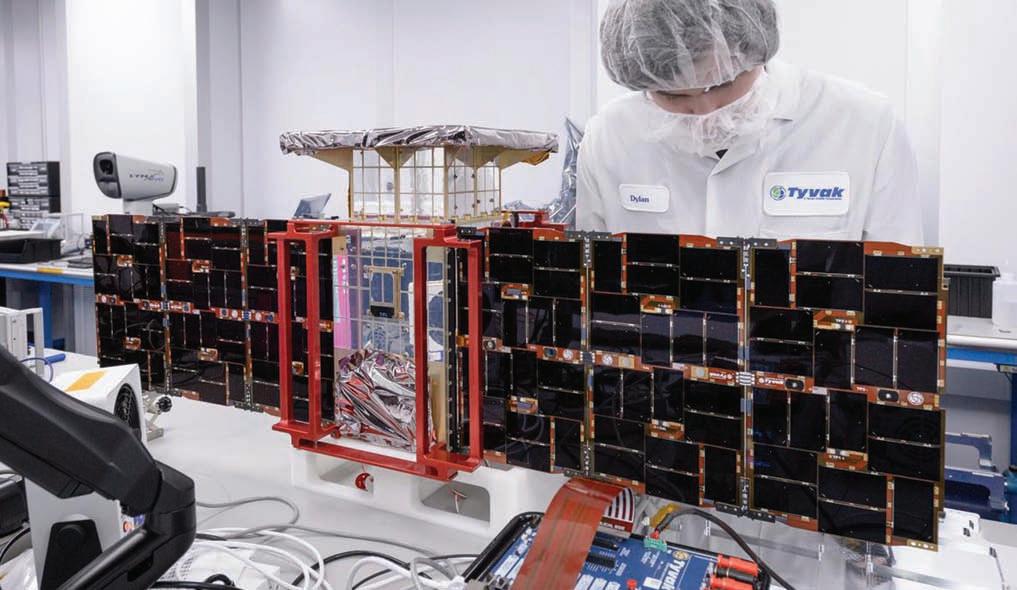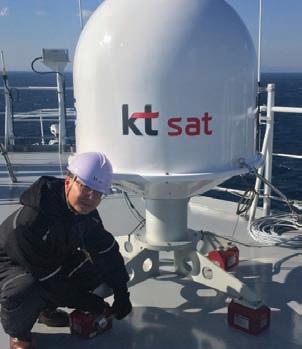
7 minute read
CAPSTONE: proving a path to the Moon
Creating a sustainable presence on the Moon and establishing a Gateway space station is still a work in progress, but the successful launch of the Cislunar Autonomous Positioning System Technology Operations and Navigation Experiment, known as CAPSTONE™, takes us one step closer to the finish line. This 55-pound CubeSat will not only test the Near Rectilinear Halo Orbit around the Moon but will also demonstrate spacecraft-tospacecraft navigation services that don’t rely exclusively on tracking from Earth.
Crispin Littlehales, Executive Editor, Satellite Evolution Group
It’s been fifty years since Eugene Cernan, Commander of the Apollo 17 mission spoke these words: “As we leave the Moon at Taurus-Littrow, we leave as we came, and God willing, we shall return with peace and hope for all mankind.” One might well ask what is taking us so long to return. Besides being a political football with a costly price tag, the game has changed. Instead of landing a few astronauts on the surface for a brief walkabout, the US wants to establish a permanent outpost—one that can be used as a stepping stone to Mars. NASA’s Artemis program proposes to do just that, and the agency is using the CAPSTONE™ mission to verify the best way forward.
SMALL SATELLITE ON A BIG MISSION
The Space Technology Mission Directorate via the Small Spacecraft Technology and Small Business Innovation Research programs at NASA’s Ames Research Center is supporting CAPSTONE’s development and the Artemis Campaign Development Division within NASA’s Exploration Systems Development Mission Directorate is supporting the launch and mission operations. The agency’s Jet Propulsion Laboratory (JPL) is backing the communication, tracking, and telemetry downlink via NASA’s Deep Space Network (DSN), Iris radio design, and groundbreaking 1way navigation algorithms.
The lunar orbiter that NASA has assigned to conduct this critical mission was built by Tyvak Nano-Satellite Systems, a subsidiary of Terran Orbital Corporation. It is 144.5 CM x 50.1 CM x 33.0 CM and has a mass of 26kg. There are two MKII deployable solar arrays providing 120W of peak power and triple redundant MKII 12V battery modules.
The satellite includes a radio tower on top and is equipped with a SWIFT-SLX S-band radio with ranging functionality provided by Tethers Unlimited, Inc. NASA/ JPL IRIS band radio provides the uplink, downlink, and navigation ranging. Redundant MKII sensors and actuators, including two star trackers, four reaction wheels, two coarse sensor modules, and two IMUs have been integrated for guidance navigation and control. An innovative hydrazine propulsion system from Stellar Exploration provides upwards of 200 M/S for orbit adjust and vehicle momentum management and there is a dedicated MKII Linux flight computer to manage on-board processing of the payload Cislunar Autonomous Position System (CAPS™) software.

Installation of solar panels. Photo courtesy NASA
The prime contractor and the lead for the mission, Advanced Space, handled the pre-launch coordination and analysis of activities to support the sustainable exploration of space.
The mission was awarded a favorable Payload Review and Determination from the Federal Aviation Administration and approval from NASA for both an Orbital Debris Assessment Report and a Planetary Protection Plan.
UP, UP, AND AWAY
Integrated into Rocket Lab’s Photon spacecraft bus inside the fairing of Rocket Lab’s Electron launch vehicle, the CAPSTONE satellite departed Earth on June 28. Minutes later the payload entered an initial low Earth orbit at an altitude of 165km. Over the next six days, Photon’s HyperCurie engine fired seven times at key intervals thrusting CAPSTONE’s orbit to around 810,000 miles from Earth before releasing the CubeSat on its ballistic lunar transfer trajectory to the moon. From that point forward the satellite uses its own propulsion, along with the Sun’s gravity to make a four-month-long journey to the Moon and enter its Near Rectilinear Halo Orbit (NRHO) on November 13th .
To ensure that CAPSTONE stays on target, the satellite needs to make periodic trajectory correction maneuvers (TCM). The first was successfully completed when the spacecraft was approximately 465,000 km from Earth and the second took place five days later when CAPSTONE was approximately 789,000 km from Earth and moving at 1,313 mph. Apogee was raised from 1.47 million km to more than 1.48 million km during the burn.
Mission operations and in-orbit support are conducted and guided by a team of specialists: the Advanced Space flight dynamics team, who designed the maneuvers and maintain knowledge of where the satellite is located; the Terran Orbital spacecraft operations team, who is responsible for spacecraft commanding activities; Stellar Exploration, who designed and built the propulsion system; and NASA’s JPL, who supported the communication, tracking, and telemetry downlink through NASA’s DSN.
Assessing a novel cislunar orbit
The NRHO that CAPSTONE will enter takes advantage of what researchers call “a gravitational sweet spot in space.” According to NASA, the orbit is located at a precise balance point in the gravities of Earth and the Moon. This makes for a stable orbit that requires minimal energy to maintain. CAPSTONE will come within 1,000 miles of the one lunar pole on its near pass and 43,500 miles from the opposite pole every seven days. The satellite will remain in this orbit for at least six months
CAPSTONE will verify the characteristics of this orbit, including power and propulsion requirements, and demonstrate the entering and maintaining of the orbital path. This not only supplies NASA with the vital logistical information needed to support the Artemis missions and the establishment of the Gateway space station which, like the ISS, would have docking ports, living quarters, and an onboard laboratory to conduct scientific investigations. Having an in-depth understanding of the NRHO is key to making Gateway a reality. Such knowledge will also be crucial to laying the foundation for commercial support for future lunar projects.

Solar panel string voltage test (red glow). Photo courtesy NASA
IMPROVED LUNAR NAVIGATION CAPABILITIES
The CubeSat’s CAPS, which was developed and implemented by Advanced Space, is also being evaluated. To test its spacecraft-to-spacecraft navigation technologies and ranging capabilities, CAPSTONE’s flight computer and radio will communicate with NASA’s Lunar Reconnaissance Orbiter (LRO) and use it as a reference to pinpoint the CubeSat’s position in space. According to NASA, this peer-to-peer information will enable future spacecraft to determine their location without having to rely exclusively on tracking from Earth, thus freeing up ground-based antennas to handle valuable science data. The CAPSTONE team coordinated with both regulators and other operators on the Moon to prevent interference in terms of radio frequency utilization when communicating with the ground and the LRO.
SO FAR, SO GOOD
On July 4, after CAPSTONE had been successfully deployed, NASA issued a statement saying that the CubeSat was experiencing communications issues while in contact with the DSN. A day later, NASA announced, “CAPSTONE made initial contact with the DSN ground station in Madrid, Spain, followed by a partial contact with the Goldstone ground station in California. From these contacts, mission operators have been able to determine CAPSTONE’S approximate position and velocity in space.” By July 8th, thanks to the efforts of the integrated mission team, the problem was resolved, and the satellite was back on track and operating normally.
NASA has set up a site for the public to follow CAPSTONE on its journey with a simulated view of the solar system using the agency’s Eyes on the Solar System interactive real-time 3D visualization: (https://eyes.nasa.gov/apps/orrery/#/home).

CAPSTONE spacecraft build at Tyvek-Nano Satellite Systems. Photo courtesy NASA






